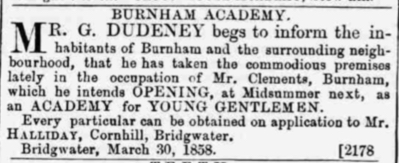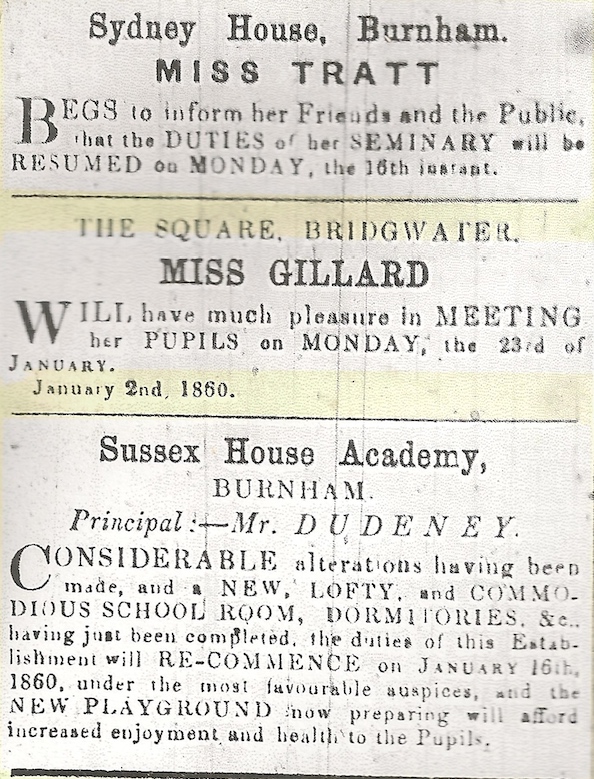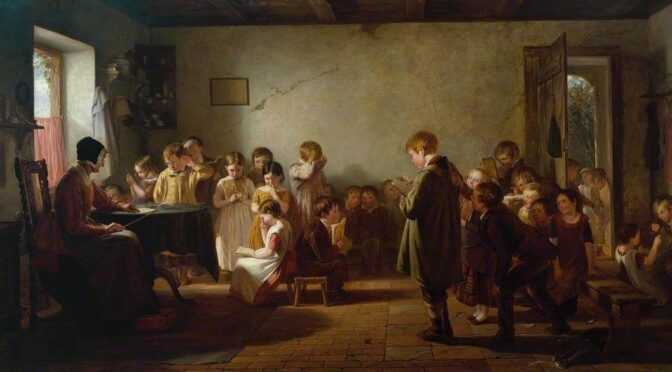The earliest information we have about schooling in Burnham is that around 1800 there was a Sunday school run by Mr Locke, the Rector of Burnham. There were no doubt other such schools run at various times before and since. In Sam Nash’s notes there is a record of a waywarden’s (responsible for highway maintenance) accounts for the parish, for 1788, which includes a Joseph Payne ‘schoolmaster’.
There is a record, also noted by Nash, of a payment of £2 10s 7½d to John Buncombe, Parish Clerk, in 1806 for education of poor children. It is not clear from this whether he was responsible for directly providing the education or merely organising it, however he did reside at ‘Homebush’ (Manor Rd, opposite the Gardens) which did have had a schoolroom adjoining. It is believed that a Miss Wood ran this school around this time so she may have been employed by Mr Buncombe.
Records of small ‘Dames’ Schools’ ( run by local women charging a small fee for very basic education) and other private establishments begin to appear as the century wore on, alongside Burnham’s first ‘National School’ (which appeared sometime shortly after 1811 and is thought to have possibly started in the Homebush premises). Some of these were probably quite short-lived. The picture at the top of the page is ‘A Dame’s School’ by Thomas George Webster (1800-1886).
Sam Nash’s notes of St Andrew’s Church records also show that a school for the adult poor existed in Burnham in 1828 and a Sarah Woods is listed as schoolmistress in association with this (see also Adult School).
In 1840 two independent schools are known in Burnham: Miss Bartlett’s Child’s School and Miss Gilling’s Ladies Boarding School. The latter was actually owned by Sarah Board and run by the occupier Ann Gilling. It was situated on Oxford St opposite the site of Ravensworth House.
There is a record in the Bridgwater Times in 1846 of a Mrs Swan moving her ‘Ladies Academy’ from Brunswick Terrace to larger premises in Prew’s Terrace (now Kinver Terrace).
The following advert appeared in The Bath Chronicle on 7th January 1847:

By 1849 there were 4 daily schools known in Burnham and 4 in Berrow. Records of 1852 & 1853 show 4 schools in Burnham and the names of Sarah Daunton and Johanna Hardwick are associated with these. In May 1854 Mrs W. Marchent is recorded as resuming the duties of her school in Brunswick place.
The new ‘National School’ on the Esplanade was opened in 1857, funded by George Reed. There is a story that Reed was in part motivated by a wish to get rid of the noise from the children in the old schoolroom at Homebush opposite his house. Robert Dunning (‘A Somerset Miscellany’, 2005) records that durning the 1870’s the school was run by a Mr & Mrs Fisher.
There is a record from 1859 of a Mr & Mrs Dudeny running ‘Sussex House Classical and Commercial Academy’. In the 1861 census a Mr Gilbert Dudeny is recorded as living in and running the Academy in a property in College St. It appears that this was in one of the buildings next to the Baptist Church.

Around 1860 Misses Jane and Eiza Tratt were running a school at Sydney House (No 2 College St). Mr Dudeney had also made improvements to his school:

By 1863 a June Hardwick is recorded as running a school in Alfred St (High St) near College St. Ann Hobbs also appears in records as running a school nearby in College St at around the same time, in Alfred House on the site of the current Lloyds Bank . The Hobbs sisters possibly ran schools in other premises prior to this. James Lovibond was also operating an establishment on the East side of Victoria St.
St John’s Church School in Highbridge was built in 1863 catering for 360 pupils.
Dunning mentions four private schools which were active during the 1870s:
Mrs Rosser who kept a “school for ladies”, some boarding, at No 8 College St.
Charles Way running a day school in Oxford St.
Simon Harris in Victoria St.
Thomas Crabb, Professor of Music, Sea View Villa on the Esplanade.
He also notes the presence of the Misses Bailey and Anne Hobbs (also listed below) during that time.
Whitby’s Directory of 1883 lists a number of schools / teachers for Burnham:
The Misses Bailey running a preparatory school in College St;
Miss Board running a ‘young ladies’ school’ in Alfred St (High St);
William Clarke running the boarding school in Ravensworth House;
H.E. Compson running a ‘young gentleman’s boarding school’ in Steart House;
Miss Dows running a ‘ladies’ school’ in Julia Terrace (Brean Down House);
Miss Ann Hobbs running a ‘ladies’ boarding and day school’ in Alfred House, College St;
W.H. May National School master;
Ernest Russell running a Burnham College ‘school for young gentlemen’
Dunning mentions three others who were active during the 1870s but had closed by 1883:
Mrs Rosser who kept a “school for ladies”, some boarding, at No 8 College St.
Simon Harris in Victoria St.
Thomas Crabb, Professor of Music, Sea View Villa on the Esplanade.
In 1891 The St Joseph’s Catholic School was opened in the grounds of La Retraite Convent.
Kelly’s directory records the Misses Weaver as running a preparatory school at Steart House in 1897 but this had gone by 1906. By this time the role of such small schools had been taken over by the larger private schools and the expanding state sector.
In 1906 the National School on the Esplanade was renamed St Andrew’s and in 1910 the infants classes moved out to an annexe in Princess St, replaced in 1914 by the purpose built Burnham Infants’ School.
See individual school pages for further details of the development of education in the town from the end of the 19th century onwards.
Information from research by Walter Strickland and by Winston and Robert Thomas (The Book of Burnham on Sea).
The list below is compiled from baptismal records and shows the names of some of the schoolmasters in Burnham during the period indicated.
1826 MacNAUGHTON John
1828 TURNER Robert
1858 GRACE Thomas
1859-65 DUDENEY Gilbert
1866 JONES William Price
1866 MILWARD John Gant
1874 BAKER James William
1880 GUILMANT Joseph Andrew Labat
1886 MAY William Henry
1888 THAIN George Osborne Miller
1896 RICHARDS William Henry Carne
1899 STRONG Charles Herbert
1901 WEBB Frederick Charles
1907-10 BIRD Kentic Holmes
1914 GLADDIS Herbert
Research by Alan Wheway


I, Christopher Kendall, was from 1942 to 1945 a pupil of Gwen Lewis School in Burnham on Sea. In 1942, aged 4, I had lived with my mother, Daphne S Kendall and her mother and father in law at 9 Lordship Park in North London. We subject to the Blitzes and then my mother was enlisted by the Department of Defence Mail Censors in Black Pool. She enrolled me at the Gwen Lewis school aged 4 year old into the care of Miss Margaret Gwendolen Lewis and Mrs Lois (Hinton) Sanders in their small preparity school, housed in Seaforth, a late Georgian house on Sea View Road and later in a Victorian brick house futher down Sea View Road. I am unsure of the number of pupils at the school, probably no more than 15 girls and boys. Using my age of four as a gauge, our ages ranged from four to eight. We slept three to five to a room. I think in addtion the Gwen Lewis and Mrs Sanders two others helped run the school. I remember no formal classes but painting pictures and playing on the sandy beach. We walked in a crocodile hand in hand in town, to the cinema, and to the coastal road and fields beyond full of wild flowers including butter cups, daisies and cowslips. I remember Italian prisoners of war, and Black American soldiers marching down Sea View Road. I remember on Dec 1st 1943 a Flying Fortress crash landed on the beach close to where we played, beside the Esplanade. We were not the only excited audiance and the whole town turned out.
Have you acess to records of the Gwen Lewis School and the events I refer to in this Comment. I am writing a narrative of my time in Burnham and am searching for more history of the area from 1942 to 1946. You are free to what I have written.
Please reply to this message even if you don’t need a record of my experience of war time Burham?
Thank you for sharing this interesting recollection with us Christopher. Unfortunately I don’t believe we have any record of the Gwen Lewis School. There were many small schools in Burnham during the 19th and early 20th centuries but it seems that the number was much reduced as the 20th century wore on. Perhaps other readers may have some information. I will also pass this on to one of our researchers who may come across something.